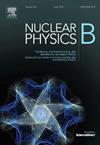加速Kerr-Newman黑洞的隐藏共形对称和全息
IF 2.8
3区 物理与天体物理
Q2 PHYSICS, PARTICLES & FIELDS
引用次数: 0
摘要
我们研究了任意加速Kerr-Newman黑洞标量波动方程中隐藏共形对称的出现。通过应用近视界低频近似,我们将四次径向函数简化为有效的二次形式,揭示了径向方程中潜在的SL(2,R)L×SL(2,R)R对称性。这使我们能够识别向左和向右移动的温度,并将波算符与二维共形场理论(CFT2)的卡西米尔相匹配。我们从接近极值黑洞的近视界几何计算中心电荷,并验证卡迪公式再现了贝肯斯坦-霍金熵。为了进一步支持加速背景下的Kerr/CFT对应关系,我们分析了标量场散射,并表明吸收截面与双CFT2相关器的有限温度预测一致。我们的研究结果提供了热力学和动力学证据,证明加速Kerr - newman黑洞的近视界区域允许使用Kerr/CFT对应进行一致的全息描述。本文章由计算机程序翻译,如有差异,请以英文原文为准。
Hidden conformal symmetry and holography for accelerating Kerr–Newman black holes
We investigate the emergence of hidden conformal symmetry in the scalar wave equation for the accelerating Kerr–Newman black hole with arbitrary acceleration. By applying a near-horizon, low-frequency approximation, we reduce the quartic radial function to an effective quadratic form that reveals an underlying symmetry in the radial equation. This allows us to identify left- and right-moving temperatures and match the wave operator to the Casimir of a two-dimensional conformal field theory (CFT2). We compute the central charges from the near-horizon geometry of a near-extremal black hole and verify that the Cardy formula reproduces the Bekenstein–Hawking entropy. As further support for the Kerr/CFT correspondence in accelerating backgrounds, we analyze scalar field scattering and show that the absorption cross section agrees with the finite-temperature prediction from dual CFT2 correlators. Our results provide both thermodynamic and dynamical evidence that the near-horizon region of the accelerating Kerr–Newman black hole admits a consistent holographic description by using the Kerr/CFT correspondence.
求助全文
通过发布文献求助,成功后即可免费获取论文全文。
去求助
来源期刊

Nuclear Physics B
物理-物理:粒子与场物理
CiteScore
5.50
自引率
7.10%
发文量
302
审稿时长
1 months
期刊介绍:
Nuclear Physics B focuses on the domain of high energy physics, quantum field theory, statistical systems, and mathematical physics, and includes four main sections: high energy physics - phenomenology, high energy physics - theory, high energy physics - experiment, and quantum field theory, statistical systems, and mathematical physics. The emphasis is on original research papers (Frontiers Articles or Full Length Articles), but Review Articles are also welcome.
 求助内容:
求助内容: 应助结果提醒方式:
应助结果提醒方式:


